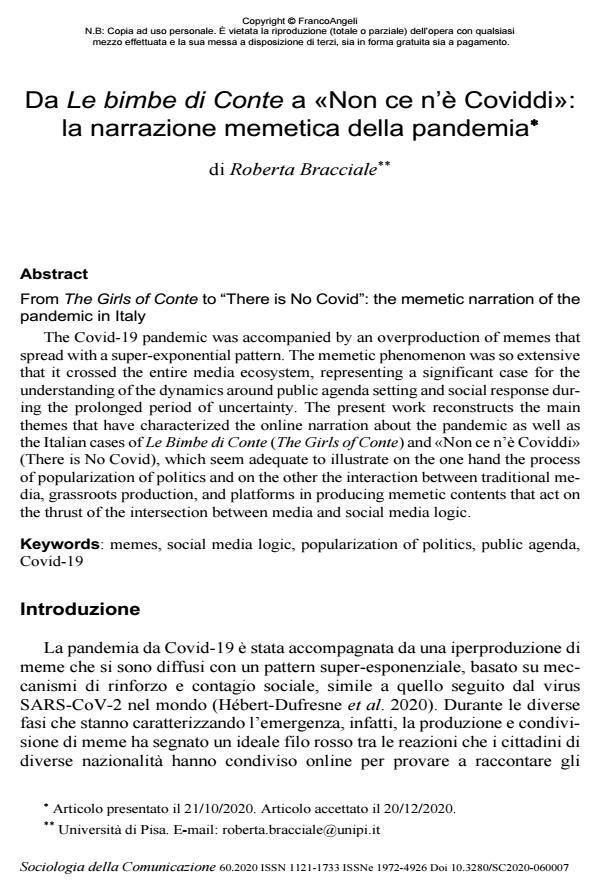Da Le bimbe di Conte a «Non ce n’è Coviddi»: la narrazione memetica della pandemia
Titolo Rivista SOCIOLOGIA DELLA COMUNICAZIONE
Autori/Curatori Roberta Bracciale
Anno di pubblicazione 2021 Fascicolo 2020/60
Lingua Italiano Numero pagine 15 P. 67-81 Dimensione file 465 KB
DOI 10.3280/SC2020-060007
Il DOI è il codice a barre della proprietà intellettuale: per saperne di più
clicca qui
Qui sotto puoi vedere in anteprima la prima pagina di questo articolo.
Se questo articolo ti interessa, lo puoi acquistare (e scaricare in formato pdf) seguendo le facili indicazioni per acquistare il download credit. Acquista Download Credits per scaricare questo Articolo in formato PDF

FrancoAngeli è membro della Publishers International Linking Association, Inc (PILA)associazione indipendente e non profit per facilitare (attraverso i servizi tecnologici implementati da CrossRef.org) l’accesso degli studiosi ai contenuti digitali nelle pubblicazioni professionali e scientifiche
;
Keywords:Memes, social media logic, popularization of politics, public agenda, Covid-19
- Beck U. (2000), La società del rischio. Verso una seconda modernità, Carocci, Roma. ed. or. 1986.
- Bennett W.L., Segerberg A. (2013), The Logic of Connective Action. Digital Media and the Personalization of Contentious Politics, Cambridge University Press, New York.
- Boni F. (2002), Il corpo mediale del leader. Rituali del potere e sacralità del corpo nell’epoca della comunicazione globale, Meltemi, Milano.
- boyd d. (2010), Social Network Sites as Networked Publics: Affordances, Dynamics, and Implications, in Zizi Papacharissi (a cura di) Networked Self: Identity, Community, and Culture on Social Network Sites, Taylor & Francis, London, pp. 39–58.
- Bracciale R., Grisolia F. (2020), Information Disorder: acceleratori tecnologici e dinamiche sociali, in «Federalismi.it» n. 11/2020, pp. 58–72.
- Bruns A. (2008), Blogs, Wikipedia, Second Life, and Beyond: From Production to Produsage, Peter Lang New York.
- Burgess J. (2006), Hearing Ordinary Voices: Cultural Studies, Vernacular Creativity and Digital Storytelling, in «Continuum» n. 20(2), pp. 201-14. DOI: 10.1080/10304310600641737
- Cerase A. (2017), Rischio e comunicazione. Teorie, modelli, problemi, Egea, Milano.
- CrowdTangle Team (2020), CrowdTangle. Facebook, Menlo Park, California, United States, -- URL: https://apps.crowdtangle.com/search/.
- Dawkins R. (1976), The Selfish Gene, Oxford University Press, Oxford; trad. It. (1979) Il gene egoista. La parte immortale di ogni essere vivente, Mondadori, Milano.
- Garmur M. (2020), How do you calculate overperforming scores?, -- https://help.crowdtangle.com/en/articles/2013937-how-do-you-calculate-overperforming-scores.
- Glaser B.G., Strauss A.L. (2017), The Discovery of Grounded Theory, Routledge, New York.
- Hébert-Dufresne L., Scarpino S.V., Young J. (2020), Macroscopic patterns of interacting contagions are indistinguishable from social reinforcement, in «Nature Physics» n. 16(4), pp. 426-31.
- Highfield T. (2016), Social Media and Everyday Politics, Polity Press, Malden (MA).
- Katz Y., Shifman L. (2017), Making sense? The structure and meanings of digital memetic nonsense, in «Information, Communication & Society» n. 20(6), pp. 825-842, DOI: 10.1080/1369118X.2017.1291702
- Kertcher C., Ornat T. (2020), ‘Siege Mentality’ Reaction to the Pandemic: Israeli Memes During Covid-19, in «Postdigital Science and Education» n. 2(3), pp. 581-587.
- Klinger U., Svensson J. (2015), The emergence of network media logic in political communication: A theoretical approach, in «New Media & Society» n. 17(8), pp. 1241-57.
- Kozinets R.V. (2010), Netnography: Doing ethnographic research online, Sage, London.
- MacDonald S. (2020), What Do You (Really) Meme? Pandemic Memes as Social Political Repositories, in «Leisure Sciences» n. 0(0). pp. 1-9, DOI: 10.1080/01490400.2020.1773995
- Mazzoleni G. (2015), Towards an Inclusive Digital Public Sphere, in Stephen Coleman, Giles Moss, e Katy Parry (ed.), Can the Media Serve Democracy?, Palgrave Macmillan UK, London, pp. 174-83.
- Mazzoleni G., Bracciale R. (2019), La politica pop online. I meme e le nuove sfide della comunicazione politica, Il Mulino, Bologna.
- Merton R.K. (1948), The Self-Fulfilling Prophecy, in «The Antioch Review» n. 8(2), pp. 193-210. DOI: 10.2307/4609267
- Mina A.X. (2019), Memes to movements: How the world’s most viral media is changing social protest and power, Beacon Press, Boston.
- Nagle A. (2017). Kill all normies: Online culture wars from 4chan and Tumblr to Trump and the alt-right, Winchester-Washington, Zero Books.
- Shifman L. (2013), Memes in a Digital World: Reconciling with a Conceptual Troublemaker, in «Journal of Computer-Mediated Communication» n. 18(3), pp. 362-77.
- ——— (2014) Memes in Digital Culture, MIT Press, Cambridge (MA).
- Van Dijck J., Poell T. (2013), Understanding social media logic, in «Media and Communication» n.1(1), pp. 2-14, 010002.
- Wanless A., BerkM. (2019), The Audience is the Amplifier: Participatory Propaganda, in Paul Baines, Nicholas O’Shaughnessy, Nancy Snow (ed.), The Sage Handbook of Propaganda, Sage, pp. 85-104.
- Wiggins B.E. (2019), The Discursive Power of Memes in Digital Culture, Routledge, New York-London.
- Wojcieszak M.E., Mutz D.C. (2009), Online Groups and Political Discourse: Do Online Discussion Spaces Facilitate Exposure to Political Disagreement?, in «Journal of Communication» n. 59(1), pp. 40-56.
Roberta Bracciale, Da Le bimbe di Conte a «Non ce n’è Coviddi»: la narrazione memetica della pandemia in "SOCIOLOGIA DELLA COMUNICAZIONE " 60/2020, pp 67-81, DOI: 10.3280/SC2020-060007